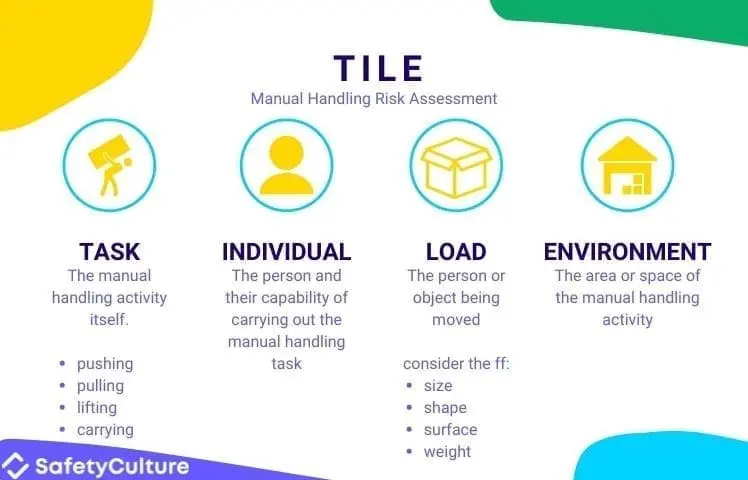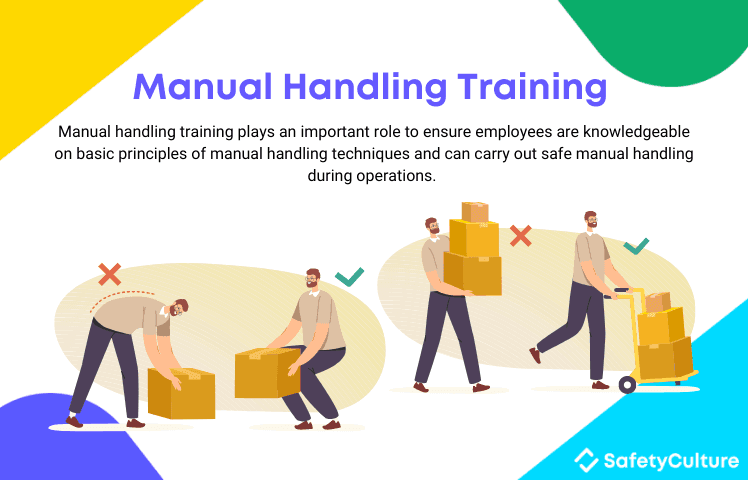What is Manual Handling?
Manual handling is an activity of transporting or supporting a load including lifting, pushing, pulling, carrying, throwing, and moving objects by hand or bodily force. It is a common practice in different industries such as manufacturing, construction, agriculture, and more. However, the Health and Safety Executive (HSE) has reported that the cause of over a third of all workplace injuries along with work-related musculoskeletal disorders (MSDs) and repetitive strain injuries are due to manual handling. Being unable to safely do it can lead to serious implications for employers and employees may suffer from injuries.
4 Key Areas of Manual Handling
Heavy manual labor, repetitive movements of arms and legs, and awkward postures can increase the risks of manual handling work-related injuries. The four key areas of manual handling:
- Task;
- Individual;
- Load; and
- Environment.
Often referred to as the acronym TILE, it can help assessors identify the risks associated with manual tasks.

Task, Individual, Load, Environment | SafetyCulture
- Task: The manual handling activity
This key area focuses on the tasks to be performed by an employee. It involves the processes and steps needed to perform an activity including appropriate employee movements such as pushing, pulling, lifting, carrying objects, as well as stooping down or twisting at the waist at any point of the process. It helps assess the needs of employees including adequate opportunity to rest and recover. - Individual: The person involved and their capabilities
This area focuses on each employee’s capabilities to carry out the task. It is important to assess individual attributes such as age, preexisting health conditions or prior injuries, acquired training, level of strength, height, and flexibility. - Load: The object being moved or transported
Load assessment does not rely only on its weight but also on other factors as well including size, shape, and surfaces. These factors can affect balance, object grasp, and handler’s view that could make it difficult, even dangerous, to move or transport. - Environment: The area of manual handling activity
It is vital to check the area of activity, especially in restricted spaces. An area with an uneven floor can cause trips that may lead to accidents, near misses, or worse, fatalities. Other environmental factors such as poor ventilation and weather conditions can also affect the performance of employees performing manual handling.
5 Principles of Manual Handling
All employers are required by the Manual Handling Operations Regulations to prevent, assess, and reduce the risk of injury from manual handling. Proper implementation of manual handling can help the organization to:
- reduce the risk of injury from hazardous manual handling;
- assess manual handling risks and implement control measures according to the hierarchy of controls for operations that cannot be avoided; and
- prevent hazardous manual handling and limit employee movements considering TILE.
According to the Health and Safety at Work summary statistics in 2019/20, there are 480,000 new or longstanding workers who suffer from work-related MSDs in Great Britain alone. The estimated main cause of this injury is due to manual handling, awkward or tiring positions, and keyboard work or repetitive action. Here are the 5 principles of manual handling that can be maximized to achieve safer lifting practices in the workplace.
- Plan – Before lifting or transporting an object, ensure to follow TILE in assessing the area. It would help assess if manual handling would involve strenuous activity and long distances for employees to strategize where to rest and recover.
- Position – Ensure to load the object evenly and use handles to maximize the power of an employee. Establish a good posture with feet about shoulder-width apart and move the center of the body as close as possible to the center before lowering to lift the object.
- Pick – Whenever possible always use two hands when lifting an object and ensure to keep the load and the person’s torso aligned and neutral before moving. Keeping a heavy load on the “power zone,” an area in the body that is horizontally between shoulders and vertically between the middle of thighs and center of the chest, helps ensure that the limbs and trunk are not forced into awkward postures to avoid the likelihood of injuries.
- Proceed – Moving from one place to another should be performed with caution. Employees should ensure that there is a clear view of the travel path and it is unobstructed to avoid tripping while performing manual handling.
- Place – Do not just drop the load immediately but instead put it down slowly, steadily, and smoothly when reaching the destination to protect employees from unnecessary strain and injury. If possible, locate the area of destination in a convenient place to help manual handlers to maintain their pace.
10 Tips to Avoid Hazards
Repetitive tasks and bad lifting habits are the usual causes of back pain that may trigger MSDs in the long run. In order to prevent this, here are some useful tips organizations can follow to avoid hazards while performing manual handling.
- Provide manual handling training and manual handling toolbox talks
- Enforce the 10 ergonomic principles to help reduce injuries and improve productivity tasks
- Keep the travel route unobstructed
- Provide manual handling details to the workers and talk over the risk factors
- Analyze injury records to pinpoint recurring problems
- Perform manual handling risk assessments
- Equip employees with mechanical aids for heavy loads
- Assign appropriate people according to individual categories to carry out the task
- Nominate a point person to coordinate collective action when employees are lifting as a team
- Keep organizational policies up-to-date
Create your own Manual Handling Checklist
Build from scratch or choose from our collection of free, ready-to-download, and customizable templates.
Browse Manual Handling ChecklistsManual Handling Training
Enforcing manual handling training is vital to ensure the safety of employees. Having a core understanding of policies, procedures, proper lifting technique, and other principles are necessary to avoid incidents. It is a mutual responsibility for employers and employees to put sensible health and safety measures in place while performing manual handling.

Manual handling training | SafetyCulture
Providing manual handling training would let employees learn the basic principles of manual handling techniques and how to properly implement them. It aids in awareness to reduce risks in the workplace and plays an important role to ensure employees can carry out safe manual handling during operations. It is important to keep the training relevant to the type of work to be carried out. Here are some factors employees should consider when performing manual handling.
- For long-distance lift, plan to rest the load midway and prepare to recover
- Change grip if necessary
- Keep the load on the power zone
- Alternate posture as well as movements
- Limit the extent of forwarding and sideways reaches
- Avoid carrying out load above the shoulder level
- Refrain from transporting loads with one hand
- Do not carry or lift an object more than individual capacity
- Always look ahead once the load has been held securely
- Find time to rest and recover
- Do not overreach on items that are placed on higher shelves, it is recommended to use equipment aids
- Ask for help if needed
- Do not use equipment if not properly trained
- Do not ignore any signs of pain or discomfort, it should be reported immediately
- If possible, perform the pushing method rather than the pulling method
- Perform body stretches to cool down after heavy work
- Change work routine among team members to avoid excessive work rates
- Maximize heavy lifting lessons
Deliver manual handling training to your teams
Prioritize every worker’s health and help keep them safe by making sure they take and complete their manual handling training. Some examples of manual handling tasks include packaging or lifting boxes, operating hand tools or other machinery, assembling products, pulling or pushing trolleys, and cleaning. If your employees are engaged in these types of activities, they are highly vulnerable to musculoskeletal injuries and other related disorders. As an employer, you have a responsibility to ensure that your business’ manual handling operations are carried out correctly so that workplace injuries and accidents are minimized. Additionally, with manual handling training, you can increase your employees’ awareness, improve their performance, and reduce absences due to injuries.
We’ve created a list of manual handling training courses that cover a range of subjects such as storing and handling chemicals, equipment, machinery, and power tools. All these courses can help prevent or eliminate serious health and safety risks in the workplace and increase workplace productivity.
Improve your EHS Management
Cultivate a safe working environment and streamline compliance with our EHS solutions.
Explore nowHow Can SafetyCulture Help with Manual Handling
Manual handling is not as simple as lifting objects, it should be performed with proper knowledge on handling techniques to avoid body strain. Conducting training and proper assessment to mitigate manual handling risks are just the beginning. With SafetyCulture (formerly iAuditor), an inspection, issue capture, and corrective action platform, employers can help their organizations keep a safe and healthy environment for their employees. Take advantage of its best features:
- use manual handling risk assessment templates anytime, anywhere, and on a mobile device even without an internet connection;
- take photos of manual handling risk factors and annotate images for improved visual reference;
- generate risk assessment reports that are securely saved in the cloud that can be shared with key personnel with a tap of a finger from wherever you are;
- train employees on the proper way to carry, lift, and move items; and
- manage your assets and inventories, all in one place.
To save you time, we have created a ready-to-use manual handling risk assessment template you can download for free and it is fully customizable according to your business needs, or you can check out our Public Library of free checklist templates that can be used by any employee in almost all industries. You also have an option to convert your existing PDF, Word Document, Excel, or PowerPoint files into SafetyCulture checklists for free up to 3 files.




